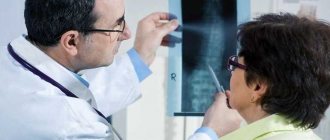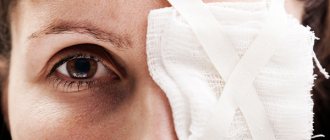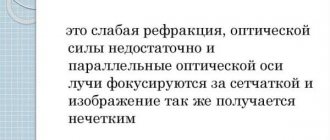Kyphosis of the thoracic spine is an excessive arched deformation of this area of the spinal column, the convexity of which is directed posteriorly. Externally, the pathology is manifested by the formation of a hump on the back.
Online consultation on the disease “Kyphosis of the thoracic spine”. Ask a question to the specialists for free: Traumatologist.
- Etiology
- Classification
- Symptoms
- Diagnostics
- Treatment
- Possible complications
- Prevention and prognosis
There are many reasons for the formation of an anomaly, ranging from genetic predisposition and back injuries to the course of diseases that negatively affect the musculoskeletal system.
The severity of clinical signs is dictated by how large the angle of deformity is. As the problem worsens, pain, rapid fatigue of the back muscles and a feeling of “pins and needles” crawling along the skin of the extremities may be expressed.
The disease has specific symptoms, so it is possible to make a correct diagnosis already at the stage of the initial examination. Additional examinations are required to confirm soft tissue damage.
To eliminate the disease, conservative methods aimed at straightening the spine are most often used. Wearing a corset and gymnastic exercises for kyphosis of the thoracic spine are considered the most effective.
Etiology
Thoracic kyphosis is considered a fairly common deviation from the norm, since it occurs in one degree or another in every tenth inhabitant of the globe. The most common pathology is among children, adolescents, and males.
Normal physiological kyphosis is found in every person - the maximum permissible deviation reaches 30 degrees. Any curvature exceeding the norm is considered an anomaly.
Deformation of the thoracic spine does not develop independently, but always occurs as a result of one or a group of predisposing factors.
The causes of the disease are considered to be:
- complicated heredity - diagnosis of Scheuermann-Mau disease in one of the closest relatives;
- disturbances in the development of the fetus inside the womb, occurring at the stage of formation and formation of the vertebrae in the embryo - in approximately 13% of cases, kyphosis is complemented by other spinal anomalies, for example, cysts, constrictions or an abnormal shape of the spinal roots;
- a wide range of spinal column injuries - in such cases, the likelihood of the disease is dictated by the severity of the injury, the factor is considered one of the most common sources of kyphosis;
- paresis and paralysis of the back muscles;
- polio;
- cerebral palsy;
- history of spinal surgery;
- lack of physical activity in a person’s life and sedentary working conditions;
- any fracture of the vertebrae in the thoracic region, which is often found in older women;
- formation of spinal tumors, both benign and malignant;
- injuries received during childbirth;
- Bekhterev's disease;
- spondylitis and other pathologies of non-infectious nature;
- the need for long-term radiation treatment, which is used to get rid of cancerous tumors;
- active growth of bone tissue between the vertebrae;
- rickets suffered in infancy;
- lack of control over posture while working or studying;
- some psychological problems, for example, children are very often embarrassed by their height and deliberately constantly slouch;
- impaired bone growth, which can be caused by avascular necrosis of hyaline cartilage;
- osteochondrosis and osteoporosis - diseases characterized by the development of degenerative processes in the spinal column;
- intervertebral hernias leading to compression of the nerve roots;
- excessive stress on the back;
- tuberculosis and other infectious processes.
Under the influence of the above factors and in the complete absence of treatment for diseases, destruction of the vertebral bodies, subsidence of the intervertebral discs, and weakening of the ligaments and muscles of the spine in the thoracic region occur.
Classification
Based on a wide range of predisposing sources that contribute to the formation of thoracic kyphosis, it is customary to distinguish the following forms of anomaly:
- congenital;
- genetic - the disease is inherited;
- compression - as a result of heavy physical activity;
- post-traumatic;
- mobile (the main reason is weakness of the back muscles);
- rachitic;
- senile or senile;
- tuberculosis;
- postoperative;
- paralytic;
- degenerative;
- radial
Clinicians distinguish the following degrees of severity of the pathology:
- normal;
- reinforced - the angle of curvature will be increased;
- straightened - in such situations a reduced angle is observed.
The enhanced form of the pathology has its own classification:
- 1st degree kyphosis - the degree of curvature is 40 degrees or less; to get rid of the anomaly, therapeutic massage and exercise therapy for kyphosis are sufficient;
- 2nd degree kyphosis - the bending angle varies from 41 to 50 degrees, treatment will include gymnastics, massage and wearing a bandage;
- 3rd degree kyphosis - the bending angle reaches 51–70 degrees;
- 4th degree kyphosis - the angle exceeds 71 degrees; if conservative treatment methods are ineffective, surgical intervention is resorted to.
Depending on the degree of prevalence there are:
- localized kyphosis;
- angular kyphosis - having a certain degree;
- total kyphosis - curvature in the form of an arc.
According to functional characteristics, they are distinguished:
- physiological kyphosis of the thoracic spine;
- pathological kyphosis of the thoracic spine;
- congenital kyphosis of the thoracic spine;
- acquired kyphosis of the thoracic spine.
Diagnosis of kyphosis of the thoracic spine
Kyphosis is diagnosed by an orthopedic doctor. The initial inspection is carried out without special equipment. The doctor asks the patient about the appearance and nature of the pain and conducts an examination. Using special tests, the doctor needs to evaluate reflexes.
At the next stage, the doctor prescribes an x-ray examination. The examination is performed in direct and lateral projections. Also, to accurately assess the condition of the spine, you need to take an X-ray in a stretched position of the spinal column.
Depending on what the x-rays showed, an MRI is prescribed. Tomography allows you to assess whether there is damage to bone tissue caused by pressure from the chest during kyphosis.
Based on a comprehensive examination, the doctor prescribes treatment procedures. Kyphosis is rarely treated with medications, since restoration of the spine is more of a mechanical process that requires effort on the part of the patient. However, in some advanced cases, surgery is required.
Symptoms
Kyphosis of the thoracic spine
At the initial stages of the disease, it is quite difficult to detect pathology, since the hump is still small in size, and the pain syndrome is absent or mildly expressed (can be ignored).
As the disease worsens, the following symptoms of kyphosis of the thoracic spine will appear:
- rounding and stooping of the back;
- narrowing of the sternum cavity;
- moving the shoulders back;
- protrusion of the anterior wall of the peritoneum;
- protrusion of the shoulder blades at the back;
- omission of the diaphragm;
- weakening of the back and abdominal muscles;
- flat feet;
- limited motor function;
- constant feeling of stiffness;
- severe muscle tension, which leads to shooting pain;
- numbness of the back and a sensation of “goosebumps” on the skin of the upper extremities;
- rapid fatigue of the back muscles;
- disorder of the act of defecation, which is expressed either by fecal incontinence, or constipation or their alternation;
- decreased appetite;
- shortness of breath and belching;
- heart rate disturbance;
- fluctuations in blood tone indicators;
- urinary incontinence;
- sexual function disorder.
If there is an increase in thoracic kyphosis in children, there is a delay in their physical development.
Diagnostics
There are no problems with establishing the correct diagnosis, especially with pathologies of 3 and 4 degrees of severity. The diagnostic process is complex, which is necessary to establish the predisposing factor most characteristic of a person.
Primary diagnosis includes a number of activities performed by an orthopedist or traumatologist:
- studying the medical history of both the patient and his close relatives;
- familiarization with life history;
- examination and palpation of the thoracic spinal column;
- assessment of the patient’s appearance;
- measurement of heart rate and blood pressure;
- neurological tests;
- sensitivity assessment;
- auscultation of the heart and lungs;
- a detailed survey of the patient will help the doctor determine the first time of onset of symptoms and the intensity of their severity, which will provide information about the degree of kyphosis.
The following instrumental procedures can confirm the diagnosis:
- X-ray of the spinal column performed in several projections;
- CT;
- MRI;
- electroneuromyography;
- Ultrasound of internal organs.
Causes of the disease
You can notice the curvature when it reaches stage 2 - 3
If your posture is correct, the curvature of the spine does not exceed 30 degrees. The presence of a deviation indicates a certain degree of kyphosis. The danger of the disease lies in the fact that symptoms appear at stages 2 or 3. In this case, physical therapy and medications are not effective. At stages 3 and 4, surgery is needed, which also does not guarantee absolute recovery.
Pathology occurs for the following reasons:
- congenital diseases of the spine;
- concomitant diseases;
- birth or postpartum trauma;
- genetic predisposition;
- diseases of the nervous system with paralysis of the back muscles;
- age-related changes in the spine;
- osteochondrosis.
These factors influence the rate of development of the disease. The pathology is especially dangerous for adolescents, since with intensive development of the body, a rapid transition of the disease to the last stage is allowed. If pathology is detected in a one-year-old child, the cause may be a birth injury. In adults, there are many provoking factors for the development of kyphosis.
Lordosis is the curvature of the spine in the sagittal plane, which is convex forward. This is the opposite of kyphosis. The disease appears in the cervical and lumbar regions.
Treatment
You can get rid of the disease using conservative methods, but surgical intervention is performed according to individual indications.
After the diagnosis is finally confirmed, patients are advised to take the following medications:
- non-steroidal anti-inflammatory drugs;
- muscle relaxants;
- medicines to improve blood circulation;
- vitamin and mineral complexes;
- corticosteroids;
- calcium preparations.
For external use, ointments and creams with a warming effect are used.
Conservative treatment of kyphosis of the thoracic spine must necessarily include:
- manual therapy;
- sleeping on orthopedic pillows;
- gymnastic exercises for thoracic kyphosis;
- therapeutic massage course;
- swimming;
- spine stretching;
- immobilization of the spinal column - using a bandage and corset for kyphosis.
Massage for kyphosis of the thoracic spine has some rules:
- light and smooth movements;
- complete relaxation of the back muscles;
- the most comfortable position of the patient’s body;
- mandatory absence of damage to the skin of the back;
- The pressure on the curved area should not be strong.
Gymnastics for kyphosis of the thoracic spine are compiled individually, taking into account the angle of curvature.
Indications for surgical intervention:
- ineffectiveness of conservative methods of therapy;
- progression of the pathology to stage 3 or 4;
- pronounced pain syndrome that cannot be controlled with medication;
- rapid progression of the disease;
- a pronounced cosmetic defect that significantly reduces a person’s quality of life.
Surgical fixation of the spine involves the installation of various structures made of titanium and titanium nickelide. In some cases, surgery alone may not be enough to achieve the desired effect.
If there is a smoothed kyphosis, strengthen the muscles of the upper back (exercises designed to strengthen the spine); if it is strengthened, they work to increase the tone of the pectoral muscles.
Bandage and corset for kyphosis of the thoracic spine
How to treat kyphosis.
The solution to the question of how to treat kyphosis should begin as early as possible. Kyphosis should be treated based on the degree of the disease.
——————————————————————————————————————————
HOW TO CHOOSE A POSTURE CORRECTOR:
READ
For degrees I and II of kyphosis, treatment is carried out by regularly performing physical exercises to strengthen and develop the back muscles ( EXERCISES to do at home ). It is the long back muscles that are responsible for properly supporting the spine. The rhomboid muscles of the back are responsible for moving the shoulder joints back, which ensures their correct position. General recommendations: sleep on a hard bed that prevents curvature of the spine during the night's rest. Swimming recommended. This sport develops all muscle groups, contributes to the overall strengthening of all body functions, and what is especially important, with all these advantages, does not put a load on the spinal column, but, on the contrary, relieves the load from the spine.
Comparative table of the main methods for eliminating the causes of thoracic kyphosis.
“BACK CORRECTOR”. | Advantages: Best price. Trains and strengthens the muscles responsible for eliminating the causes of kyphosis. Develops “muscle memory” of the correct position of the back and spine. Disadvantage: as the child grows, you need to purchase a larger size corrector. Usage: 30 minutes several times a day. |
Prevention and prognosis
You can completely avoid or significantly reduce the likelihood of pathology formation using the following preventive measures:
- maintaining an active lifestyle;
- avoiding spinal injuries;
- sleeping on a hard mattress;
- fight against excess body weight;
- taking vitamin complexes;
- timely treatment of any anomalies of the musculoskeletal system;
- Regularly undergoing a comprehensive preventive examination at the clinic.
The prognosis for kyphosis localized in the thoracic spine is favorable—the curvature can often be completely eliminated (thoracic kyphosis is smoothed out), and the patient’s quality of life improves. Complications develop quite rarely, and no death has been recorded.











